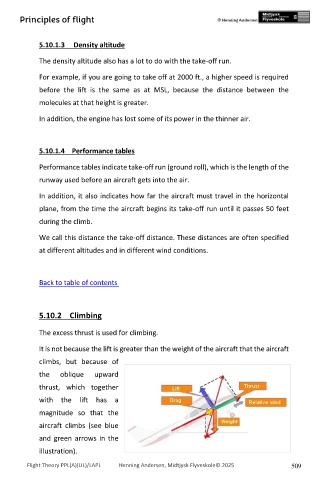Page 509 - PPL-engelsk 2025
P. 509
Principles of flight
5.10.1.3 Density altitude
The density altitude also has a lot to do with the take-off run.
For example, if you are going to take off at 2000 ft., a higher speed is required
before the lift is the same as at MSL, because the distance between the
molecules at that height is greater.
In addition, the engine has lost some of its power in the thinner air.
5.10.1.4 Performance tables
Performance tables indicate take-off run (ground roll), which is the length of the
runway used before an aircraft gets into the air.
In addition, it also indicates how far the aircraft must travel in the horizontal
plane, from the time the aircraft begins its take-off run until it passes 50 feet
during the climb.
We call this distance the take-off distance. These distances are often specified
at different altitudes and in different wind conditions.
Back to table of contents
5.10.2 Climbing
The excess thrust is used for climbing.
It is not because the lift is greater than the weight of the aircraft that the aircraft
climbs, but because of
the oblique upward
thrust, which together
with the lift has a
magnitude so that the
aircraft climbs (see blue
and green arrows in the
illustration).
Flight Theory PPL(A)(UL)/LAPL Henning Andersen, Midtjysk Flyveskole© 2025 509

